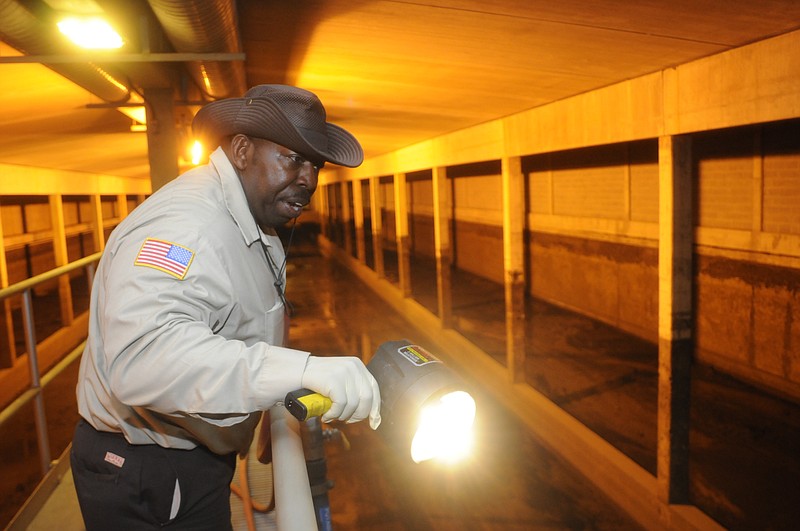It starts with a flush.
Miles away, that flush surfaces at Moccasin Bend sewage treatment plant's "gates of hell" - three stories below ground where a massive pipe gushes about 65 million gallons a day of raw sewage and sewage-tainted stormwater runoff into our 50-year-old treatment plant that has been upgraded or expanded at least three times.
Along the way, and especially on rainy days, our flushes may be slowed along the way to the treatment plant in any one of eight enormous underground storage tanks that most Chattanoogans don't even know exist.
The cavernous tanks are called combined sewage overflow facilities - CSOs, for short - and their construction, beginning in the 1990s, cost about $50 million. The largest, the size of two football fields behind Howard School of Academics and Technology on Market Street, can hold 7 million gallons. That's about seven Tennessee Aquariums.
The giant tanks were designed to slow the flow of stormwater runoff that mixes with the flushes in Chattanooga's oldest and most city-centric sewage lines. When the weather calms, the stored tainted water can proceed at normal pace to the treatment plant before being released clean into the Tennessee River.
But the fact that those massive engineering wonders can't always prevent occasional unhealthy overflows should help us understand why adequate sewage treatment - while not a sexy topic to learn about - is both important and costly. In this very rainy year, overflows continued to spew up through manholes or pour over outfalls into the river from which we draw our drinking water. Between July 1 and Sept. 30, Chattanooga's required quarterly report to EPA noted 43 sewer overflows and 60 outfall discharges totaling tens of millions of gallons.
We really need to get this right, and sooner rather than later.
On most days, the city's more than 80 pumps and more than 1,250 miles of sewer line (in 2010 only about 70 miles of that line sometimes mixed with stormwater runoff) work perfectly - sending all of our mess out of sight and out of mind into one of those big holes and eventually to the gate of Moccasin Bend. Once in the plant, the waste gets chlorinated, treated and returned to the river. The city's recent years of work, prompted by a federal mandate, has improved our odds for cleaner water. The city reported 361 overflows in 2011. Since 2013, overflows have fallen by an average of 17 percent a year, records show.
Moccasin Bend's gate actually receives wastewater from far more homes and industries than just those in Chattanooga proper. Also flowing into the treatment plant is waste from Red Bank, Hamilton County, Soddy-Daisy, East Ridge, Collegedale and Lookout Mountain (Tennessee and Georgia), Rossville, Walker County, parts of Wildwood, Fort Oglethorpe and Ringgold.
Unfortunately, regionwide we too often think about what makes our flush work only twice: When it doesn't work, and when we get our sewer bill.
In Chattanooga, sewer rates have risen nearly 10 percent a year since 2012 to pay for the city's Clean Water Act fixes - a $250 million mandate from the U.S. Environmental Protection Agency to stop the overflows. The average 5,000-gallon user in the city saw rates rise from $25.10 a month in 2011 to around $50 today. The city's residential customers pay for their sewer based on their water usage as measured by the water meter at their homes.
The city's regional customers, including WWTA, pay based on the total amount of flow that a city or WWTA sends to the city's system. The regional utilities set their own residential and business sewer fees to cover that and other costs. WWTA, which expects soon to sign its own $240 million consent degree with EPA to fix problems, now charges its average residential user $54 a month, but likely will increase that by 8 percent to 10 percent annually over the next decade.
To make it simple, local residents are paying about $1.70 a day to whoosh away all our waste and dirty bath water and every other form of liquid waste that we wisely or unwisely put down a drain somewhere. Our cost might go up to about $2 or $3 a day in coming years.
Truthfully it's not a lot of money. Most of us spend more on coffee. A tall black coffee at one popular pit stop is $1.85.
And we certainly don't want that coffee to taste or smell like sewage, do we?
